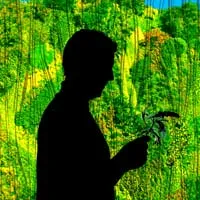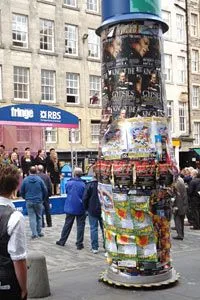Edinburgh Fringe Festival
Written by

The Edinburgh Fringe in 2009 had more shows and ticket sales than any previous Fringe. When you're already talking about the biggest arts festival in the world, that's no small feat in the middle of an economic recession!
James Hadley shares his personal highlights from 23 show samplings in four days.
* * *
A year on from my first experience of the Edinburgh Fringe Festival, I returned - having seen about 200 of London's diverse theatrical offerings in the interim. And that did make a difference to how I perceived things one year on. You get a little spoilt for choice when you have access to so many productions of world-class quality year round, so why take a train for four and a half hours to a colder, greyer (albeit prettier) city so you can see lots of productions of variable quality?
I guess it's the thrill of the lottery, and the knowledge that this is where all the performing artists who want to be discovered are gathered vying for our attention. Statistics would probably support the idea that out of the thousands of shows, and thousands of producers/venue managers/directors/theatre critics, there are bound to be some 'discoveries'.
And it's official - the Fringe in 2009 had more shows and more ticket sales than any previous Fringe. When you're already talking about the biggest arts festival in the world, that's no small feat in the middle of an economic recession! Apparently, despite last year's box office system crashing right at the start of the Fringe (to general pandemonium), this year's advance ticket sales were the strongest ever. Many put this down to the number of people choosing 'staycations' instead of overseas summer holidays.
Well the staycationers may have been disappointed on the summer side of that - as it again rained on more days of the Fringe than it didn't - but they certainly weren't short on things to do. Once again the Edinburgh Fringe was an absolute onslaught of frantic performers handing out flyers all along the Royal Mile. Once again there seemed to be just about any kind of performing arts experience you could possibly hope to sample on offer. Once again everyone's back broom cupboard seemed to have been converted into a performance venue for the three weeks of the Festival. And once again I found myself dashing over cobble-stone streets back and forth across town to get from one show to the next in gaps that somehow never seemed long enough not to have to run.
So what was causing a buzz? There was a general consensus among the leading critics that many of the best shows within the Festival were to be found at the Traverse Theatre - Scotland's new writing theatre. It always hosts some of the most professional productions to be found in the Fringe, but this year its selection of shows was exceptionally strong - receiving rave reviews and booking out by the start of the festival. I'm relying upon the planned London transfers of several of these productions to find out what I missed. The two productions that I did get to at the Traverse were certainly in the top five of the 23 shows I viewed during my four day visit (it's quite standard to see six shows a day in the Fringe - the drive to fit as many shows in as possible is just one of the symptoms of being a Fringe junkie; symptoms which spread like an airborne virus).
My first show at the Traverse was 'The Doubtful Guest' by established professional company Hoipolloi. This was their second adaptation of an Edward Gorey picture book, the first being 'My Uncle Arly'. I couldn't have imagined a more consummate adaptation of Gorey's twisted Gothic aesthetic if Tim Burton had been directing. 'The Doubtful Guest' was an absurd little entertainment of a family of adult characters who are haunted by an unwelcome guest in their home. You could probably read it as a parable about society's responses to terrorism, but that would be taking it far too seriously. This was an entertainment of such delightfully pure entertainment that it reduced its audience to child-like open-mouthed wonder. There was something brilliant about the clown-like characters - so earnest in their fearfulnes that they were hilarious.
The other show I saw at the Traverse was 'A Life in Three Acts' - a three part theatrical biography of Bette Bourne. Bette is a devotee of Quentin Crisp who spent much of his life leading the Bloolips troupe of drag queens. His life story, shaped into scripted format by playwright Mark Ravenhill from a series of conversations that were then recreated between them onstage, is a wonderful overview of the last fifty years of queer history in London. There were colourful anecdotes of living in a squat as part of a drag commune, and of his first discovery of drag after joining the gay liberation front in the 'sixties. But also powerful moments of raw anger and anguish as he talked of his violent father and of the initial impact of AIDS in 1983. The honest emotion of these theatrical memoirs was far more affecting than any of the more 'acted' performances I saw in other productions.
One of the fringiest but least theatrically successful productions I saw was of Chekhov's 'Ivanov' set in a swimming pool by emerging company Gems of Mazal. It was a quirky idea which almost worked in places - Ivanov a literal island in the middle of the pool as everyone else sat around the outside, characters splashing and dunking each other, Ivanov's wife drowning... but the dynamism of the water and the noisy acoustics of the set-up were constantly upstaging the acting and confusingly abridged script.
Equally fringey, but a far more successful production, was the epic folk musical 'Sporadical' by Little Bulb Theatre. This was staged as part of the free fringe programme programme of experimental theatre presented at Forest Fringe, which is like an Edinburgh satellite venue for Battersea Arts Centre and features mostly artists who are working with BAC in London. 'Sporadical' was a fantastically quirky and home-made looking tall story of family ancestors coupling with mermaids and over-protective mothers who shatter glasses with their operatic singing. The ridiculousness of it all was underpinned with some excellent folk musicianship, including the female drummer who constantly thrashed her long hair around as if she were playing heavy metal. This was the kind of fringe discovery that people sit through all the dross to find - a diamond in the rough that has 'cult hit' written all over the company's future.
Most beautiful and theatrically astounding of the shows I saw were two works by Scottish Dance Theatre - 'A Visitation' and 'Luxuria'. The same company of young dancers - technically brilliant - working with two choreographers of exciting vision.
'A Visitation' had a clutter of wooden mannequins, Victorian furniture and performers dressed in deconstructed nineteenth century underwear blended with tartan suits. Flood-lit by footlights, the performers moved through intricate duets and trios, their whitened faces with dark eye makeup adding to the Gothic charge of the piece, which explored the effects of a haunting sylph upon the other characters.
Whereas 'Luxuria' was one of the most lyrical and romantic dance pieces I've ever seen - women pirouetting in full silk crinoline dresses, and continuing to do so as men lifted them up on their shoulders. Men being lifted by women and swung round and round, then moving through all sorts of vaguely erotic acrobatic couplings - all to rousing string arpeggios.
But my favourite show of all I saw (because no, I'm going to spare you an account of all the instantly forgettable shows you sit through to find the memorable productions) was 'Susurrus' by David Leddy. This was effectively a radio play which you listened to on headphones as you followed a mapped out trail through Edinburgh's Botanical Gardens. So there were no live performers at all. What resulted was a memorable experience of exploring the gardens - a series of cultivated vistas unfolding in tandem with an affecting story of four voices who turn out to be interlinked around a family tragedy.
The piece has a recurring central motif of Benjamin Britten's opera of 'A Midsummer Night's Dream' which links it in to the journey through the park in only a tangential way I suppose. Some criticised the piece for barely relating to the park in itself at all, though there are little details of resonance worked into the piece throughout. You find yourself sitting on a bench beneath a willow and hearing about a character having come there on a daily basis while processing a trauma, and somehow being an echo of their presence as you listen to their voice is potently affective - as if you're reliving their experience of the place, rather than relating to an onstage character at one degree of remove. As you walk from site to site on the journey, operatic arias accompany you, so it's all rather serene and contemplative, other audience members fellow silent wanderers in their own parallel experience.
The great thing about the Edinburgh Fringe is that there is so much to choose from that anyone is going to find something to appeal to them, regardless of their tastes. There's an awfully huge proportion of vanity pieces and amateur productions which seem to be more about the performers having an Edinburgh Fringe experience than about meaningfully connecting with the audience. But there's also a sprinkling of some of the most exciting and innovative performance practitioners, both emerging and established, all thrown together in a far more democratic lucky dip of a festival than you're likely to find anywhere else.
